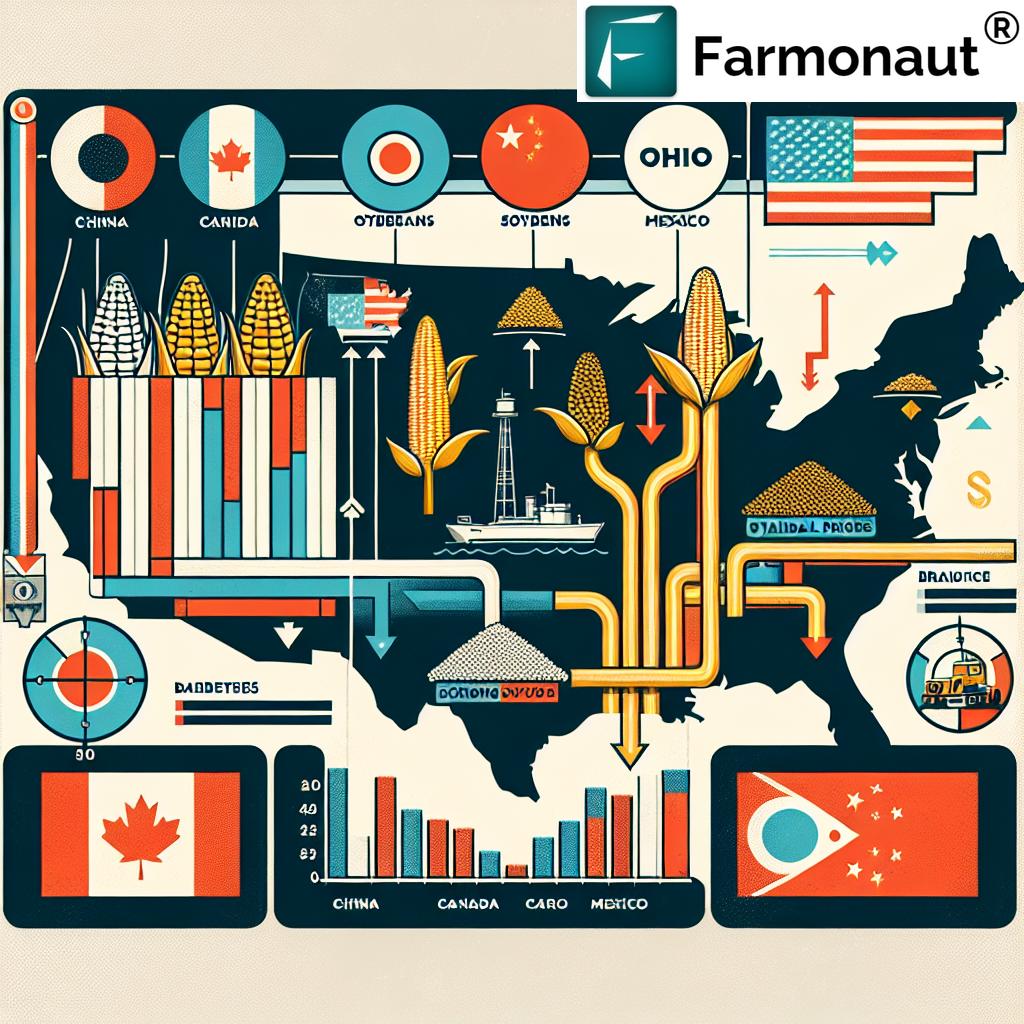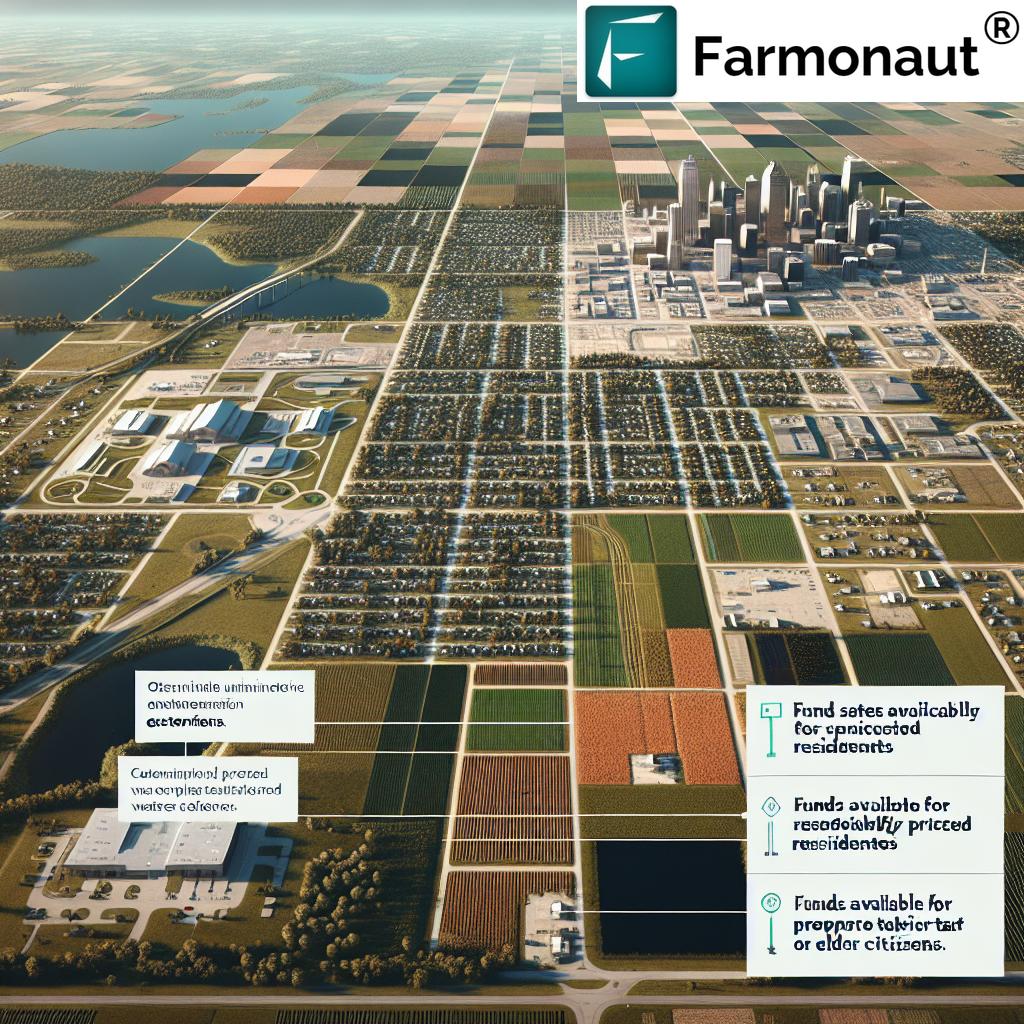Ohio Farmers Navigate Trade Tensions: Impact on Soybean and Corn Exports
“Ohio’s soybean and corn exports face challenges as tariffs reshape the global agricultural market, affecting over 75,000 farms statewide.”
In the heart of America’s agricultural heartland, Ohio farmers are grappling with unprecedented challenges as international trade tensions reshape the global market for soybeans and corn. As we delve into this complex issue, we’ll explore how these trade disputes are impacting Ohio’s agricultural sector, examine the ripple effects on farm income and commodity prices, and analyze the strategies farmers are employing to navigate these turbulent times.
The Shifting Landscape of Agricultural Trade
The agricultural sector in Ohio, like much of the United States, has long relied on robust export markets to sustain its operations. However, recent trade tensions, particularly with China, have thrown this delicate balance into disarray. The imposition of tariffs and counter-tariffs has created a climate of uncertainty, leaving farmers to question the future of their livelihoods.
Let’s break down the key factors influencing this situation:
- Tariffs on U.S. agricultural products by China and other countries
- Retaliatory measures by the U.S. government
- Shifting global demand for soybeans and corn
- Fluctuating commodity prices
- Increased competition from other exporting nations, particularly Brazil
These factors have combined to create a perfect storm for Ohio farmers, many of whom are now facing thin margins and rising costs. The situation is particularly acute for soybean and corn growers, as these crops represent a significant portion of Ohio’s agricultural exports.
Soybean Exports: A Case Study in Trade Tension
Soybeans have become a focal point in the ongoing trade disputes, particularly between the United States and China. As the largest consumer of soybeans globally, China’s decisions have an outsized impact on the market. The imposition of a 25% tariff on U.S. soybeans by China in 2018 sent shockwaves through the industry.
Impact on Ohio Soybean Farmers:
- Reduced export volumes to China
- Lower commodity prices
- Increased competition from Brazilian soybean exports
- Need to find alternative markets
Kirk Merritt, executive director of the Ohio Soybean Association and Ohio Soybean Council, notes, “Export markets are a big deal. It’s an important source of revenue for our family farms.” With approximately half of Ohio’s soybean revenue coming from exports, the stakes are undeniably high.

Corn Exports: Facing Similar Challenges
While soybeans have garnered much of the attention, corn exports from Ohio are also feeling the pressure of trade tensions. China’s 15% tariff on U.S. corn has compounded existing challenges in the market.
Key Issues for Ohio Corn Farmers:
- Reduced demand from traditional export markets
- Pressure on commodity prices
- Increased domestic supply leading to lower prices
- Need for market diversification
Professor Ian Sheldon, Andersons Chair in agricultural, trade and marketing at Ohio State University, observes, “Additional tariffs, particularly to corn and soybeans, are just going to exacerbate the fact that we’re losing market share to Brazil. It’s intensifying the loss of market share for U.S. farmers.”
The Ripple Effects on Ohio’s Agricultural Economy
The impact of these trade tensions extends far beyond the farm gate. Ohio’s agricultural sector is a significant contributor to the state’s economy, and disruptions in this industry have wide-reaching consequences.
Economic Implications:
- Reduced farm income
- Potential job losses in related industries
- Decreased local tax revenue
- Reduced spending power in rural communities
Mary Smallsreed, a former president of the Trumbull County Farm Bureau, highlights the precarious position of many farmers: “We operate on slim margins. We buy retail and sell wholesale.” This reality underscores the vulnerability of farmers to market fluctuations and trade disputes.
“US agricultural exports to China dropped by approximately 50% in 2018 due to trade tensions, significantly impacting Ohio farmers.”
Adapting to a New Reality: Strategies for Ohio Farmers
In the face of these challenges, Ohio farmers are not standing idle. Many are employing innovative strategies to navigate the changing landscape of agricultural trade.
Adaptation Strategies:
- Diversifying export markets
- Exploring alternative crops
- Implementing cost-saving measures
- Leveraging technology for improved efficiency
- Seeking government support and assistance
One area where technology is making a significant impact is in precision agriculture. Platforms like Farmonaut are helping farmers optimize their operations through satellite-based crop health monitoring and AI-driven advisory systems. These tools can help farmers make more informed decisions about resource allocation, potentially mitigating some of the financial pressures caused by trade tensions.
The Role of Government Support
In response to the trade tensions and their impact on farmers, the U.S. government has implemented various support measures. These include:
- Direct payments to farmers affected by tariffs
- Increased funding for agricultural export promotion programs
- Negotiations aimed at opening new markets for U.S. agricultural products
While these measures have provided some relief, many farmers and industry experts argue that they are not a long-term solution. The focus, they say, should be on resolving trade disputes and establishing stable, mutually beneficial trade relationships.
Looking to the Future: Prospects for Ohio’s Agricultural Exports
As we look ahead, the future of Ohio’s agricultural exports remains uncertain. Much will depend on the resolution of ongoing trade disputes and the ability of farmers to adapt to changing market conditions.
Key Factors to Watch:
- Progress in trade negotiations with China and other key partners
- Development of new export markets
- Advancements in agricultural technology and practices
- Changes in global demand for soybeans, corn, and other agricultural products
- Potential shifts in U.S. agricultural policy
Despite the challenges, many in Ohio’s agricultural community remain cautiously optimistic. Ralph Wince, grain merchandiser for Heritage Cooperative, notes, “We’ve got a little time to see how it’s going to play out. If tariffs are in effect by the time we get to October, it could have an impact.”

The Importance of Market Diversification
One of the key lessons emerging from the current trade tensions is the importance of market diversification. Ohio farmers are increasingly looking beyond traditional export destinations to mitigate risk and find new opportunities.
Potential Growth Markets for Ohio Agricultural Exports:
- Southeast Asian countries (e.g., Vietnam, Indonesia)
- Middle Eastern nations
- African countries with growing populations and increasing food demand
- Emerging economies in South America
Diversification efforts are not limited to geographical markets. Many farmers are also exploring value-added products and niche markets to increase their resilience to trade fluctuations. This could include organic produce, specialty grains, or processed food products.
To support these diversification efforts, farmers are increasingly turning to technology. For instance, Farmonaut’s traceability solutions can help farmers and agribusinesses ensure the authenticity and quality of their products, which is crucial when entering new markets or premium segments.
The Role of Technology in Navigating Trade Challenges
As Ohio farmers grapple with the complexities of international trade, technology is emerging as a crucial tool for maintaining competitiveness and adapting to changing market conditions.
Key Technological Advancements:
- Precision agriculture tools for optimizing resource use
- AI-driven crop management systems
- Blockchain-based traceability solutions
- Advanced weather forecasting and climate modeling
- Data analytics for market trend analysis
These technologies can help farmers make more informed decisions, improve efficiency, and potentially offset some of the financial pressures caused by trade tensions. For example, Farmonaut’s crop advisory services use satellite imagery and AI to provide farmers with real-time insights into crop health and potential issues, allowing for timely interventions that can improve yields and reduce losses.
The Environmental Dimension: Sustainability Amidst Trade Tensions
While navigating trade challenges, Ohio farmers are also increasingly focused on sustainability. This emphasis on environmental stewardship is not only ethically important but can also open up new market opportunities and potentially provide a competitive edge.
Sustainability Initiatives:
- Adoption of conservation tillage practices
- Implementation of precision agriculture to reduce resource use
- Exploration of cover crops to improve soil health
- Investment in renewable energy sources for farm operations
- Participation in carbon credit markets
Technologies like Farmonaut’s carbon footprinting tools can help farmers quantify their environmental impact and identify areas for improvement. This data can be valuable not only for improving on-farm practices but also for accessing markets that prioritize sustainably produced goods.
The Human Element: Supporting Ohio’s Farming Communities
Behind the statistics and market trends are the human stories of Ohio’s farming communities. The stress and uncertainty caused by trade tensions can have significant personal and social impacts on these communities.
Supporting Farming Communities:
- Mental health resources for farmers and their families
- Financial counseling services
- Community support networks
- Educational programs for diversification and adaptation
- Advocacy efforts to ensure farmers’ voices are heard in policy discussions
It’s crucial to remember that the resilience of Ohio’s agricultural sector is not just about economics – it’s about preserving a way of life and supporting the communities that form the backbone of the state’s rural areas.
Export Comparison of Ohio Soybeans and Corn
| Crop Type | Pre-Trade Tension Export Volume (million bushels) | Current Export Volume (million bushels) | Pre-Trade Tension Export Value ($ millions) | Current Export Value ($ millions) | Percentage Change in Volume | Percentage Change in Value | Primary Export Destinations (pre-tension vs. current) |
|---|---|---|---|---|---|---|---|
| Soybeans | 150 | 100 | 1,500 | 900 | -33.33% | -40% | China, EU vs. EU, Southeast Asia |
| Corn | 200 | 180 | 800 | 650 | -10% | -18.75% | Japan, Mexico vs. Mexico, South Korea |
Looking Ahead: The Future of Ohio’s Agricultural Exports
As we conclude our exploration of the impact of trade tensions on Ohio’s soybean and corn exports, it’s clear that the sector faces significant challenges. However, it’s equally evident that Ohio’s farmers are resilient, innovative, and determined to adapt to these new realities.
Key Takeaways:
- Trade tensions have significantly disrupted traditional export markets for Ohio’s soybeans and corn.
- Farmers are actively seeking new markets and implementing diversification strategies.
- Technology and sustainability initiatives are playing crucial roles in maintaining competitiveness.
- Government support, while helpful, is not seen as a long-term solution by many in the industry.
- The resilience of Ohio’s farming communities will be crucial in navigating these challenges.
While the future remains uncertain, the adaptability and innovation demonstrated by Ohio’s agricultural sector provide reasons for cautious optimism. As Kirk Merritt of the Ohio Soybean Association puts it, “Our farmers are very productive – they can meet all our domestic needs for food and crops and still feed the rest of the world. We’d like to keep that success story going.”
FAQ Section
Q: How have trade tensions affected Ohio’s soybean exports?
A: Trade tensions have led to reduced export volumes to China, lower commodity prices, and increased competition from other exporting nations, particularly Brazil.
Q: What strategies are Ohio farmers using to adapt to these challenges?
A: Farmers are diversifying export markets, exploring alternative crops, implementing cost-saving measures, leveraging technology for improved efficiency, and seeking government support.
Q: How is technology helping farmers navigate these challenges?
A: Technologies like precision agriculture tools, AI-driven crop management systems, and blockchain-based traceability solutions are helping farmers optimize operations, make informed decisions, and potentially offset some financial pressures.
Q: What role does sustainability play in this context?
A: Sustainability initiatives can open up new market opportunities and provide a competitive edge. Many farmers are adopting conservation practices, implementing precision agriculture, and exploring carbon credit markets.
Q: What is the outlook for Ohio’s agricultural exports?
A: While challenges remain, many in the industry are cautiously optimistic. The sector’s resilience, coupled with ongoing efforts to diversify markets and adopt new technologies, provides hope for the future.
Earn With Farmonaut: Affiliate Program
Earn 20% recurring commission with Farmonaut’s affiliate program by sharing your promo code and helping farmers save 10%. Onboard 10 Elite farmers monthly to earn a minimum of $148,000 annually—start now and grow your income!
As Ohio’s farmers continue to navigate the complexities of international trade, tools and technologies that enhance efficiency and decision-making will be crucial. Platforms like Farmonaut offer valuable support in this endeavor, providing data-driven insights that can help farmers optimize their operations and adapt to changing market conditions.
In conclusion, while the challenges facing Ohio’s soybean and corn exports are significant, the resilience, innovation, and adaptability of the state’s agricultural sector provide reasons for optimism. As farmers continue to navigate these turbulent waters, their ability to leverage new technologies, explore new markets, and adapt to changing conditions will be key to ensuring the continued success of Ohio’s agricultural exports.
















